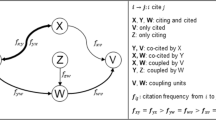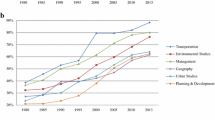Abstract
The method of author cocitation analysis (ACA) was first presented by White and Griffith in 1981 as a “literature measure of intellectual structure” and its applicability for the mapping of areas of science has since then been tested in various bibliometric science mapping studies. In this study, an experimental method of calculating the first or single author cocitation frequency is presented and compared with the standard method. Applying Ward’s method of clustering, the analysis revealed that the two approaches did not produce similar results and a tentative interpretation of deviations was that the experimental method provided with a more detailed depiction of the specialty structure. It was also concluded that a number of additional research questions need to be resolved before a comprehensive understanding of the suggested method’s merits and demerits is reached.
Similar content being viewed by others
References
Ahlgren, P., Jarneving, B., Rousseau, R. (2003), Requirements for a cocitation similarity measure, with special reference to Pearson’s correlation coefficient. Journal of the American Society for Information Science and Technology, 54(6): 550–560.
Ding, Y., Chowdhurry, G., Foo, S. (1999), Mapping the intellectual structure of information retrieval studies: an author co-citation analysis, 1987–1997. Journal of Information Science, 25(1): 67–78.
Everitt, B., Landau, S., Leese, M. (2001), Cluster Analysis. Fourth edition. London: Arnold.
Hubert, L., Arabie, P. (1985), Comparing partitions. Journal of Classification, 2: 193–218.
Kaufman, L., Rousseeuw, P. J. (1990), Finding Groups in Data. An Introduction to Cluster Analysis. New York: John Wiley & Sons.
Kendall, M. G., Gibbons, J. D. (1990), Rank Correlation Methods. Fifth edition. London: Griffin.
Leydesdorff, L. (1987), Various methods for the mapping of science. Scientometrics, 11(5–6): 295–324.
Leydesdorff, L., Vaughan, L. (2006), Co-occurrence matrices and their applications in information science: extending ACA to the web environment. Journal of the American Society for Information Science and Technology, 57(12): 1616–1628.
Mccain, K. W. (1990), Mapping authors in intellectual space: a technical overview. Journal of the American Society for Information Science, 41(6): 433–443.
Mojena, R. (1977), Hierarchical grouping methods and stopping rules: An evaluation. Computer Journal, 20(4): 359–363.
Persson, O. (1994), The intellectual base and research fronts of JASIS 1986–1990. Journal of the American Society for Information Science, 45(1): 31–38.
Persson, O. (2001), All author citations versus first author citations. Scientometrics, 50(2): 339–344.
Rand, W. M. (1971), Objective criteria for the evaluation of cluster methods. Journal of the American Statistical Association, 66(336): 846–850.
Rousseau, R., Zuccala, A. (2004), A classification of author co-citations: definitions and search strategies. Journal of the American Society for Information Science and Technology, 55(6): 513–529.
Schneider, J. W., Larsen, B., Ingwersen, P. (2007): Comparative study between first and all-author co-citation analysis based on citation indexes generated from XML data. In: Torres-Salinas, D., Moed, H. F. (Eds), Proceedings of ISSI 2007, 11th International Conference of the International Society for Scientometrics and Informetrics, CSIC, Madrid, Spain; June 25–27, 2007. Madrid: CSIC, p. 696–707.
Wessa, P. (2007), Free Statistics Software. Office for Research Development and Education, version 1.1.21, URL http://www.wessa.net.
White, H. D. (1981), Cocited author retrieval online: an experiment with the social indicators literature. Journal of the American Society for Information Science, 1981 (January): 16–21.
White, H. D. (2003), Author cocitation analysis and Pearson’s r. Journal of the American Society for Information Science and Technology, 54(13): 1250–1259.
White, H. D., Grifith, B. C. (1981), Author co-citation: a literature measure of intellectual structure. Journal of the American Society for Information Science, 32(3): 163–171.
Wishart, D. (2006), Clustan Graphics Primer. A Guide to Cluster Analysis. Fourth edition. Edinburgh & St. Andrews: Clustan Limited.
Yeung, K. Y., Ruzzo, W. L. (2001), Details of adjusted Rand Index and clustering algorithms. Supplement to the paper “An empirical study on principal component analysis for clustering gene expression data”. In: Technical Report 20000 UW-CSE-00-11-01. Department of Computer Science and Engineering, University of Washington.
Zhao, D. (2006), Towards all-author co-citation analysis. Information Processing & Management, 42(6): 1578–1591.
Author information
Authors and Affiliations
Corresponding author
Rights and permissions
About this article
Cite this article
Jarneving, B. A variation of the calculation of the first author cocitation strength in author cocitation analysis. Scientometrics 77, 485–504 (2008). https://doi.org/10.1007/s11192-007-1943-1
Received:
Published:
Issue Date:
DOI: https://doi.org/10.1007/s11192-007-1943-1




